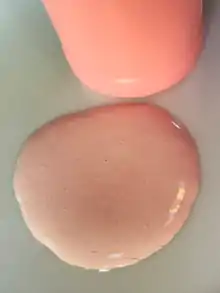Calamine
Calamine, also known as calamine lotion, is a medication used to treat mild itchiness.[2][3] This includes from sunburn, insect bites, poison ivy, poison oak, and other mild skin conditions.[4][5] It may also help dry out skin irritation.[1] It is applied on the skin as a cream or lotion.[2]
 | |
| Combination of | |
|---|---|
| zinc oxide | astringent |
| ferric oxide | antipruritic |
| Clinical data | |
| Pronunciation | KAL-ə-mine[1] |
| Other names | Calamine lotion |
| License data | |
| Routes of administration | Topical |
| ATC code | |
| Legal status | |
| Legal status |
|
| Identifiers | |
| CAS Number | |
| PubChem CID | |
| ChemSpider | |
| KEGG | |
| ChEMBL | |
| Chemical and physical data | |
| 3D model (JSmol) | |
SMILES
| |
InChI
| |
Side effects may include skin irritation.[4] It is considered to be safe in pregnancy.[4] Calamine is a combination of zinc oxide and 0.5% ferric oxide (Fe2O3).[6] The lotion is produced with additional ingredients such as phenol and calcium hydroxide.[6][7]
The use of calamine lotion dates back as far as 1500 BC.[8] It is on the World Health Organization's List of Essential Medicines.[9] Calamine is available over-the-counter as a generic medication.[5]
Medical uses
Calamine is used to treat itchiness.[2] This includes sunburn, insect bite, or other mild skin conditions.[4][5]
Effectiveness
The FDA recommends applying some topical over-the-counter skin products, such as calamine, to absorb the weeping of the skin caused by poisonous plants such as poison ivy, poison oak, and poison sumac. For relieving the pain or itching caused by these plants, the FDA document recommends a cold water compress and topical corticosteroids.[10]
References
- "Calamine (topical) medical facts from Drugs.com". www.drugs.com. Archived from the original on 2017-11-07.
- British national formulary : BNF 69 (69 ed.). British Medical Association. 2015. p. 801. ISBN 9780857111562.
- World Health Organization (2009). Stuart MC, Kouimtzi M, Hill SR (eds.). WHO Model Formulary 2008. World Health Organization. p. 303. hdl:10665/44053. ISBN 9789241547659.
- "Aqueous Calamine Cream BP - Summary of Product Characteristics (SPC) - (eMC)". www.medicines.org.uk. 18 November 2016. Archived from the original on 30 December 2016. Retrieved 29 December 2016.
- Hamilton, Richart (2015). Tarascon Pocket Pharmacopoeia 2015 Deluxe Lab-Coat Edition. Jones & Bartlett Learning. p. 191. ISBN 9781284057560.
- Braun-Falco, Otto; Plewig, Gerd; Wolff, Helmut Heinrich; Burgdorf, Walter (2012). Dermatology (2 ed.). Springer Science & Business Media. p. 1724. ISBN 9783642979316. Archived from the original on 2016-12-29.
- Ma, Joseph K. H.; Hadzija, Boka (2012). Basic Physical Pharmacy. Jones & Bartlett Publishers. p. 327. ISBN 9780763757342. Archived from the original on 2016-12-30.
- Bendich, Adrianne; Deckelbaum, Richard J. (2016). Preventive Nutrition: The Comprehensive Guide for Health Professionals (5 ed.). Springer. p. 608. ISBN 9783319224312. Archived from the original on 2016-12-30.
- World Health Organization (2019). World Health Organization model list of essential medicines: 21st list 2019. Geneva: World Health Organization. hdl:10665/325771. WHO/MVP/EMP/IAU/2019.06. License: CC BY-NC-SA 3.0 IGO.
- "Outsmarting Poison Ivy and Other Poisonous Plants". U.S. Food and Drug Administration: Consumer Updates. 9 June 2021 [Originally posted c. June 2009, since updated but advice unchanged]. Archived from the original on 5 June 2009.
External links
- "Calamine". Drug Information Portal. U.S. National Library of Medicine.